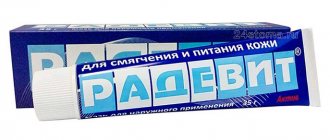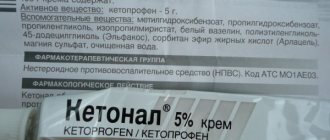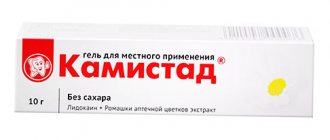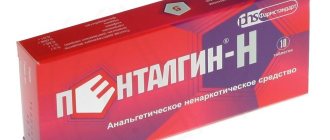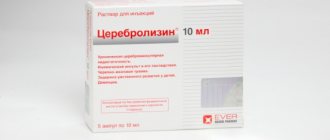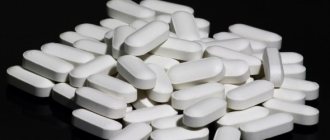Ichthyol ointment is an anti-inflammatory, antiseptic, analgesic for external use. Used in the treatment of dermatological and gynecological diseases, if necessary, to relieve inflammatory processes in arthritis. It is applied to the pathological lesion in a thin and at the same time dense layer; a bandage is required. The “compress” is kept for 4-12 hours, the duration of therapy usually does not exceed 14 days.
The cost of Ichthyol ointment ranges from 95-125 rubles.
Pharmacodynamics and pharmacokinetics
Ichthammol, which is part of the ointment as an active substance, a local irritating effect on the sensitive endings of nerve fibers when directly exposed to the mucous membranes and skin In this case, weak irritation is gradually replaced by a decrease in the sensitivity of the latter, which leads to the development of reflexes that change the trophism of tissues.
Causes denaturation of protein molecules. Absorbed by mucous membranes and skin. It has a positive effect on inflamed skin and subcutaneous layers (especially in combination with alcohol), restores blood circulation, regulates the tone of blood vessels, improves metabolism, and increases the elasticity of the skin.
The analgesic effect of the drug on the deep layers of soft tissue, as a rule, appears several hours after treatment of the affected area.
Main properties of Ichthyol ointment:
- ability to relieve pain and inflammation. Ichthammol inhibits the activity of the enzymes cyclooxygenase and lipoxygenase , which are involved in the breakdown of arachidonic acid , and thus prevents the formation of compounds that are powerful mediators of inflammation. In addition, the substance reduces the production of prostaglandins , thereby reducing the intensity of pain.
- Antibacterial action . The properties of the drug are manifested against Gram (+) bacteria, which are the main causative agents of skin infections in humans. In particular, ichthammol is effective against epidermal and Staphylococcus aureus , as well as against group A streptococci .
- Antimycotic action . Certain dermatophytes (for example, the zoophilic fungus Microsporum canis and the geophilic fungus Microsporum gypseum ) show high sensitivity to 0.2% solutions of ichthamol , while to disrupt the life processes of pathogens of candidiasis (C. albicans) and mold onychomycosis (S. brevicaulis, Aspergillus spp. ) products with a higher concentration of the substance are used.
The effect of ichthyol in ointment
Ichthyol ointment 10% is an effective drug for the treatment of skin and joint inflammation. How does the ointment work?
The active substance (ichthyol) inhibits the production of inflammatory mediators. In this regard, its effect is similar to the work of non-steroidal anti-inflammatory drugs, as a result of which joint pain is reduced and the development of inflammation is limited. In case of inflammation, ichthyol ointment acts as an analgesic - it reduces inflammation and reduces pain .
Ichthyol also slightly irritates the nerve endings, and this increases blood circulation and vascular tone in the area where the ointment is applied. As a result, the nutrition of tissues improves (in medical terminology, their trophism), the elimination of metabolic products is accelerated, and as a result, the area of inflammation decreases and the amount of pus (if any) decreases. Thanks to the tone of the vessels, their lumen narrows and the flow of fluid to the site of inflammation decreases. Which leads to a decrease in swelling.
Thus, ichthyol ointment draws out pus, treats inflammation on the skin (boils, dermatitis, post-burn redness) and in subcutaneous tissues (joints).
Treatment of inflammation has an effect on reducing pain. Therefore, ichthyol ointment is called not only an anti-inflammatory, but also an analgesic.
Indications for use
Indications for the use of Ichthyol ointment are skin diseases ( erysipelas , burns, eczema , abscesses, etc.), arthritis and neuralgia of a traumatic or inflammatory nature .
The properties of ichthammol allow the drug to be used in gynecology and urology for the treatment of inflammatory diseases of the pelvic organs ( metritis and parametritis , prostatitis , salpingitis and a number of other diseases).
Why is Ichthyol ointment used for varicose hemorrhoidal veins?
The use of the drug in the treatment of external and internal hemorrhoids is due to its ability to disinfect inflamed hemorrhoids , stop inflammation and eliminate painful manifestations of hemorrhoids ;
accelerate cell restoration and tissue epithelization, thus promoting the healing of anal fissures; stimulate the outflow of venous blood, improve blood circulation in the rectal area, reduce itching and discomfort in the anus.
Interaction with other drugs
Ichthyol ointment is not recommended for use simultaneously with other antiseptic external agents such as iodine and preparations containing alkaloids and heavy metal salts. This combination can cause severe skin irritation, even deep burns.
All preparations for internal use, as well as for intramuscular/intravenous injections, are absolutely compatible with ichthammol-based ointment.
We recommend reading about the best ointment for acne. From the article you will learn about the most effective ointments for acne, medications for inflammation with antibiotics, and indications for the use of hormonal medications for acne. And here is more information about what ointment to use for psoriasis in children and adults.
Ichthyol ointment is considered one of the most effective drugs in the treatment of inflammatory and infectious pathologies on the skin, as well as some diseases of internal organs. It is used in short courses, significantly speeds up the healing and regeneration processes, and practically after the first use it stops inflammation and promotes the removal of purulent contents.
Ichthyol ointment: instructions for use
Ichthyol ointment is used as a means of external therapy. The drug, without rubbing, is applied in a thin layer to the affected areas and covered with a piece of gauze.
After the procedure, you should wash your hands thoroughly.
The duration of use is determined by the doctor depending on the diagnosis and characteristics of the clinical picture. The instructions for use of Ichthyol ointment indicate that liniment can be used by an adult 2-3 times a day.
When using ointment for boils or hidradenitis to the boil or inflamed sweat gland and firmly fix a gauze pad on the sore spot. The treatment is repeated every 8-10 hours.
Using Ichthyol ointment for acne, the product is applied to the inflamed area pointwise and covered with a cotton swab. After 2 hours, the remaining ointment can be removed.
Ichthyol against acne can also be used in the form of masks. This method of using the drug is suitable for people with extensive acne .
Apply the ointment to the face in a thick layer, avoiding the skin around the eyes and lips, for at least 2 hours, then remove it with a cotton pad and wash the face with milk. affected by acne are treated with a product containing salicylic acid .
It is recommended to make a mask at least 2 times a week. Since the drug has an unpleasant odor, it is better to use it before bed.
Use in gynecology involves the use of tampons soaked in ointment and a 10% glycerin , which are inserted intravaginally 1 or 2 times a day.
For hemorrhoids, the drug can be used either in pure form or in combination with glycerin . To prepare lotions with glycerin , take the ingredients in equal parts and mix them until a homogeneous mass is obtained.
When used externally, the ointment is carefully applied with massage movements to painful areas 1-2 times a day (without rubbing!). For rectal use, the ointment is applied to a gauze swab, and then - after spontaneous cleansing of the intestines or a cleansing enema - the tampon is carefully inserted into the anus. It is better to do the procedure before bedtime.
The appearance of burning and pain are signals to consult a doctor. Consultation with a specialist is also required if, after 2 weeks of using the ointment, the patient does not experience any positive dynamics.
Ichthyol – antiseptic
Ichthyol (or ingammol
, or in chemical terminology -
ammonium bituminous sulfate
) is a resinous substance from shale rocks. It is a concentrate of organic substances with a large amount of sulfur. Ichthyol is obtained by multi-stage processing of organic resin found in sedimentary shale rocks.
Note: the name “ichthyol” is translated from Greek as “fish” or “fish oil”. This is due to the fact that skeletal remains of prehistoric fish are often found in shales.
In the production of ichthyol, shale resins are sublimated and distilled, after which they are treated with alkali, sulfuric acid and ammonia water, after which they are evaporated and a medicinal substance is obtained.
It was introduced into treatment practice at the end of the 19th century by the German physician Paul Unna. The medicine was given anti-inflammatory, antiseptic and analgesic effects
. It was intended for external therapy of skin and joint diseases, inflammations.
Today, ichthyol ointment is a traditional remedy for the treatment of purulent wounds . It is available in a concentration of 10%
.
Treatment with ichthyol ointment is used in dermatology, urology, gynecology and veterinary medicine. At the same time, the veterinary composition differs in concentration ( 20%
instead of
10%
).
Ichthyol ointment 20%
has a more pronounced effect. Therefore, sometimes patients use the veterinary composition for a quick therapeutic effect. Ichthyol contains a lot of organic sulfur. Therefore, its effect is similar to sulfur ointment (also antiseptic and anti-inflammatory).
special instructions
Ichthyol ointment is a safe product, the use of which is permissible even during pregnancy and lactation. However, some precautions must be taken when using this product.
Avoid swallowing the ointment and getting the ointment in the eyes. In addition, it is not intended for treating deep wounds.
The drug can leave stubborn stains on furniture and clothing, so it is recommended to cover the areas of skin treated with it with a bandage.
Composition and release form
In everyday life, the ointment is often called “ichthyol.” The active ingredient is ammonium bituminous sulfonate or ichthammol. This is one active ingredient in the composition of Ichthyol ointment, containing many components.
Release form
| Tradename | Ichthammol content | Excipients |
| Ichthyol ointment | 10 or 20% | Petrolatum |
| Ichthyol, ointment | 10 or 20% | Petrolatum |
| Ichthyol, rectal suppositories | 200 mg | Witepsol |
The product for external use 10% contains 10 g. ichthammol in 90 gr. Vaseline. The ratio of active ingredient and base in the 20% preparation is 20 and 80 g. respectively.
The ointment looks like a thick dark brown mass and has a heavy odor. The drug is available in glass and plastic jars of 20, 25, 40 and 50 g, aluminum tubes of 15, 30, 40 g.
The product leaves stains on clothes and bedding.
Ichthyol is obtained by distilling bituminous shale with the remains of phytoplankton from ancient seas. The final product is rich in aromatic hydrocarbons. Contains biologically available sulfur, which is important for skin diseases.
Analogs
Level 4 ATC code matches:
Ichthyol
Ichthyol , Fitoval , Antisept 70 and 96% , Antiseptol , AHD 2000 , Balsamic liniment (according to Vishnevsky), Biosept , Diamond green , Incidin liquid , Potassium permanganate , Manisoft , Sodium tetraborate , Hydrogen peroxide , Septol , Ethyl alcohol 70% , Steri lium , Fukortsin , Chlorophyllipt , Ectericide .
Ichthyol ointment or Levomekol?
Levomekol is an antimicrobial agent based on methyluracil and chloramphenicol . It is used to cleanse wounds from purulent-necrotic masses (a sterile piece of gauze is impregnated with the ointment and loosely filled into the wound); it can be introduced into the purulent cavity using a catheter.
Thus, the drugs have different purposes, and it is incorrect to compare them. The choice is influenced by what this or that remedy is prescribed for. So, for purulent wounds it is advisable to use Levomekol , while ichthyol will cope better with boils .
Vishnevsky ointment or Ichthyol ointment?
Liniment Vishnevsky is a combined drug intended for the treatment of skin abscesses and phlegmon of soft tissues , carbuncles and boils , lymphadenitis , burns and frostbite, varicose and postpartum ulcers , thrombophlebitis , cephalosporosis , osteomyelitis , obliterating endarteritis , hemorrhoids , some diseases of the female genital area, radiculitis .
Shows antimicrobial activity, relieves inflammation, disinfects and stimulates local immunity.
In most cases, the drugs are interchangeable. Before making a choice in favor of one remedy or another, you should consult your doctor.
What to choose - Ichthyolka or Levomikol
If treatment of inflamed, purulent wounds is required, then doctors give preference to Levomekol - its corresponding properties are more pronounced. In gynecological practice, Levomekol is also more often prescribed - it does not irritate the mucous membranes. In general, this drug has the main difference from “ichthyolka” - it is absolutely odorless, so it can be actively used for the treatment of inflammatory and infectious skin diseases.
Reviews of Ichthyol ointment
Ichthyol ointment is a multifunctional product at a low cost, therefore, according to most consumers, it must be present in every home medicine cabinet.
The drug has found wide use for abscesses and eczema , it is used as a remedy for boils and acne, it is used to treat burnt skin and broken knees, and to treat thrush and hemorrhoids .
Many women claim that the drug is an indispensable tool for combating skin imperfections. The use of Ichthyol ointment for acne - reviews and photographs confirm this - allows you to relieve inflammation (regardless of its type), disinfect the affected area, reduce the size of acne , accelerate the release of the purulent contents of pustules and the resorption subcutaneous pimples , as well as reduce their pain, narrow pores, remove peeling and soften the skin.
There are also many references on the Internet to the use of ichthyol for hemorrhoids . Reviews indicate that in cases where the disease is not too advanced, the drug will solve and effectively solve this delicate problem.
Almost everyone calls the only disadvantage of the product its unpleasant smell, but the mass of beneficial properties and the complex effect of the drug completely cover this disadvantage.
pharmachologic effect
The drug is well absorbed into the skin and penetrates deep into the epidermis, which determines its effectiveness in the treatment of skin lesions. Pharmacological action of ichthyol ointment:
- Improves blood supply - more oxygen enters the tissues, and the infiltrate is brought to the surface.
- By affecting the permeability of capillaries, the ointment eliminates inflammation, pain and swelling.
- The pronounced antibacterial effect is due to the influence of sulfur, which destroys proteins in the cells of the pathogen.
- Inhibits the process of decay and promotes the formation of new layers of the epidermis (keratoplastic effect).
A combined product containing ichthammol - zinc-ichthyol ointment, or rather a paste - is similar in action to ichthyol; it is used to treat eczema, dermatitis, burns and purulent skin lesions.
Symptoms of rosacea, special forms, diagnostic examination and treatment of the disease:
Price of Ichthyol ointment
How much liniment costs depends on the pricing policy of the manufacturing company and the volume of the tube/can. In Russian pharmacies, the price of Ichthyol ointment varies from 16 to 125 rubles.
In Ukraine, the drug costs from 6 to 18 UAH.
- Online pharmacies in RussiaRussia
- Online pharmacies in UkraineUkraine
ZdravCity
- Ichthyol ointment for external use.
approx. 10% of bank 25gZAO Yaroslavl f.f. 71 RUR order - Ichthyol ointment for external use. approx. 20% of bank 25gZAO Yaroslavl f.f.
75 rub. order
Pharmacy Dialogue
- Ichthyol ointment 20% 25gYaFF
27 RUR order
- Ichthyol ointment (tube 20% 25g)BZMP
68 RUR order
- Ichthyol ointment (can 20% 25g) Tula FF
65 rub. order
- Ichthyol ointment 20% 25g Tverskaya FF
61 rub. order
- Ichthyol ointment 10% 25g Tverskaya FF
41 rub. order
show more
The choice of remedy depending on the severity of the injury
Burns are classified according to the depth of the lesion and the area of damaged skin. There are 4 stages of injury.
The first is characterized by redness and burning of the epidermis. The second is characterized by deeper damage. Fluid-filled blisters may form on the skin. These stages can be treated at home with ointments and creams.
If stages 3 or 4 are diagnosed, causing tissue necrosis, the patient is placed in a burn department. In some cases, such patients require surgery.
To treat damage, it is important to choose the right product. Medicines differ in their main active ingredient and have different effects on the skin. Some ointments are designed to heal superficial wounds, others trigger the process of regeneration of the deeper layers of the epidermis.
A high-quality ointment must meet the following criteria:
- suitable for treating different types of burns;
- have an analgesic effect;
- quickly heal wounds and regenerate damaged cells;
- protect against infection and inflammation.
Contraindications
Before using any medicines, you should carefully read the instructions for use. Most anti-burn ointments have contraindications and can cause an adverse reaction.
- A categorical ban on the use of drugs is individual intolerance to the components.
- Antibiotic-based medications are not recommended for renal and liver failure, during pregnancy and in childhood.
- Herbal preparations and those with the addition of propolis can cause allergic rashes.
In order not to aggravate the situation and prevent complications, you should not self-medicate. Even if the burn seems mild, it is better to visit a doctor . He will assess the extent of the damage and prescribe a drug suitable for a particular case.
